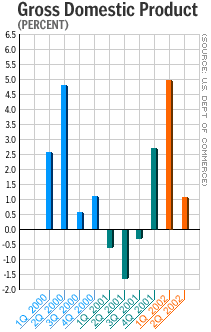NEW YORK (CNN/Money) -
The U.S. economy got a wide-ranging report card this week, and the results were, well... mixed.
In June, CNN/Money determined that the economy was a C+ student -- not failing, but nowhere near the head of the class. Recent data have done nothing to dispel that notion.

On one hand, some reports have raised fears that the economy could "double dip" back into recession, while others have justified the belief of most economists that a double dip is nothing more than an ice-cream cone -- the economy's not great right now, but it's not going to fall off the table, and strong growth will return by next year -- if not sooner.
At this point, the fate of the economy seems to depend on the outcome of a tug-of-war between U.S. consumers and U.S. businesses.
Consumers, whose spending makes up about two-thirds of total U.S. gross domestic product (GDP), have so far kept the economy going, shrugging off a weak labor market, falling stock prices and the threat of war in Iraq to keep buying cars and houses.
Businesses, on the other hand, spend far less, but they're critical to the economy because they give the consumers jobs.
Businesses have been working at cross purposes to consumers this year. They've been nervous about all the same things consumers are nervous about, but nobody's offering them zero-percent financing on factory equipment, office buildings or computers -- and many businesses have too much of that stuff anyway, so they have little desire to buy more.
Businesses have also been slow to hire workers back, after cutting more than 1.5 million jobs during a recession that began in March 2001.
Nevertheless, recent data have shown that, so far, consumers appear to be winning the battle and keeping the economy afloat.
"People who are seeing things negatively are pointing to excesses" in business' production capacity, debt and other factors, said Lakshman Achuthan, managing director of the Economic Cycle Research Institute. "But the excess won't force us into a recession; it just keeps us from going strong."
The ECRI's weekly leading index, a compilation of seven economic indicators, rose this week, and Achuthan said it's been pointing to anemic growth that could last for between two and four quarters. But it will be growth nonetheless, and the economy should be stronger thereafter.
So far, the majority of economists agree with that view -- but there are risks. Here's how the economy's performing right now, judging by recent data.

Consumer confidence: Scandals at Enron, WorldCom and more led to a tumble in stock prices and finally got to the ever-cheerful consumer -- closely watched confidence indexes from the Conference Board the University of Michigan have fallen recently -- though they're still higher than they were after the 1990-91 recession.

Consumer spending: Americans bought cars in August like they were going out of style, but they stayed out of Wal-Mart, Target and other chain retailers. It's still too early to tell if weak retail sales are a trend or an anomaly; but if consumers go into hibernation, the economy will, too.

Business spending: Business spending on equipment and software rose in the second quarter for the first time since the third quarter of 2000. New orders for machinery -- including industrial machinery -- rose 13.4 percent in July, the biggest gain since the Commerce Department started keeping records.
If this trend continues or accelerates, happy days will be here again. As Achuthan pointed out, however, that could take a while.

Labor market: Wall Street was thrilled with the drop in August's unemployment rate. Many economists were not.
"The economy and the job market are not out of the woods yet," said Sung Won Sohn, chief economist at Wells Fargo & Co.
Though businesses have been expanding their payrolls in recent months, they haven't hired nearly enough people to keep unemployment falling. New claims for unemployment benefits have risen above the benchmark 400,000 level again, and layoff announcements rose 46 percent in August.
Hopefully, consumers will not be too unhappy when unemployment rises again, as many economists think it will.

Housing market: It just doesn't quit. Mortgage rates fell to yet another new low this week. New and existing home sales continue to set records. If the economy's going under water, housing is on stilts ... or a bubble. For the economy's sake, it had better not be the latter.

Manufacturing: This week, the Institute for Supply Management (ISM) said its key measure of manufacturing activity was still in positive territory, but just barely, in August. And reports that factory orders were strong in July, Chicago-area manufacturing is still healthy and mid-Atlantic region manufacturing is weak add to a picture of an industry still tentatively recovering from a prolonged downturn.

Stock market: Stocks ended their precipitous slide in late July and have been scratching and clawing back ever since. Of course, if you believe bear-market guru Bill Gross, the Dow Jones industrial average is going to fall to 5,000. But most observers don't believe him.
"Nope. Not unless we get a Japan-style deflation; 5000 Dow just ain't gonna be," said David Kotok, chief investment officer at Cumberland Advisors in Vineland, N.J.

Dollar: The dollar is still as weak as it was in June, but the bottom hasn't dropped out. A weaker dollar is helping U.S. exporters such as Procter & Gamble Co. (PG: Research, Estimates), without being so weak that it discourages overseas investment.

Overall: Despite a miserable stock market, the economy still seems on track to turn in a better performance this year than 2001's pitiful 0.3-percent growth in gross domestic product (GDP) -- maybe more than 3 percent. That's not the A+ performance of the late 1990s, but it's still a passing grade.

|

